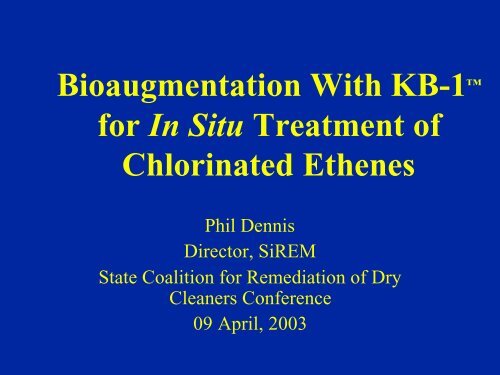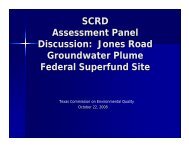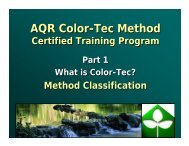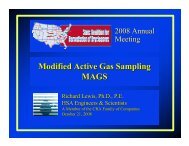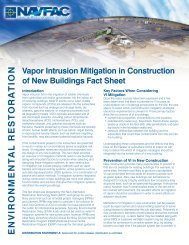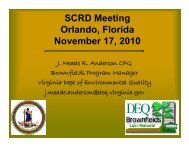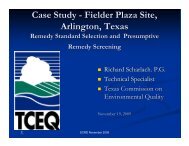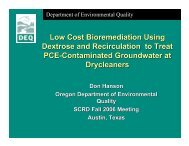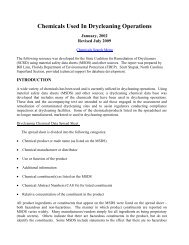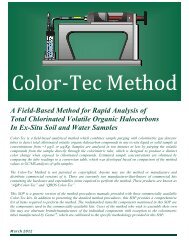Bioaugmentation With KB-1⢠for In Situ Treatment of Chlorinated ...
Bioaugmentation With KB-1⢠for In Situ Treatment of Chlorinated ...
Bioaugmentation With KB-1⢠for In Situ Treatment of Chlorinated ...
You also want an ePaper? Increase the reach of your titles
YUMPU automatically turns print PDFs into web optimized ePapers that Google loves.
<strong>Bioaugmentation</strong> <strong>With</strong> <strong>KB</strong>-1 <br />
<strong>for</strong> <strong>In</strong> <strong>Situ</strong> <strong>Treatment</strong> <strong>of</strong><br />
<strong>Chlorinated</strong> Ethenes<br />
Phil Dennis<br />
Director, SiREM<br />
State Coalition <strong>for</strong> Remediation <strong>of</strong> Dry<br />
Cleaners Conference<br />
09 April, 2003
Presentation Overview<br />
Background on Dehalococcoides<br />
– Role in reductive dechlorination<br />
– Distribution<br />
– Detection<br />
<strong>In</strong>troduction to <strong>KB</strong>-1 Dechlorinator<br />
Kelly AFB, TX – <strong>Bioaugmentation</strong><br />
Case study with <strong>KB</strong>-1
Role <strong>of</strong> Dehalococcoides (DHC)<br />
Dehalococcoides ONLY<br />
KNOWN microorganisms<br />
that mediate complete<br />
dechlorination <strong>of</strong><br />
chloroethenes to ethene<br />
At Sites Where DHC is<br />
absent dechlorination stalls<br />
at cis-DCE (Hendrickson et<br />
al., 2001)<br />
SEM <strong>of</strong> DHC Courtesy S. Zinder
Distribution <strong>of</strong> Dehalococcoides<br />
<strong>In</strong> contrast to bacteria that biodegrade<br />
hydrocarbons, evidence exists that DHC<br />
bacteria are NOT ubiquitous in the<br />
environment<br />
– Molecular surveys (Hendrickson et al., 2002)<br />
– <strong>In</strong>complete dechlorination observed at hundreds<br />
<strong>of</strong> sites under natural and enhanced conditions
Field Detection <strong>of</strong> Dehalococcoides<br />
Gene-Trac Testing <strong>for</strong>:<br />
Presence/absence indigenous DHC<br />
Monitoring <strong>KB</strong>-1 dispersion in situ<br />
Offered commercially by SiREM
What is <strong>KB</strong>-1 Dechlorinator<br />
Mixed anaerobic culture <strong>for</strong> in situ<br />
bioaugmentation <strong>of</strong> chloroethene sites<br />
Natural culture enriched<br />
DNAPL site<br />
from a TCE<br />
Contains several strains <strong>of</strong><br />
Dehalococcoides<br />
Free <strong>of</strong> known pathogens<br />
NOT genetically modified<br />
DAPI Stained <strong>KB</strong>-1 500X magnification
DGGE Analysis <strong>of</strong> <strong>KB</strong>-1<br />
A = Dehalococcoides sp.<br />
B= Dehalococcoides sp.<br />
F = Spirochaetes<br />
G= Sulfuricurvum (sulfur oxidizer)<br />
H= Beta Proteobacteria<br />
I = Related to Rice Paddy Soil<br />
Bacterium (Candidate Division WS3)<br />
J = same as I<br />
P = Spirochaetes<br />
Q = Dehalococcoides sp.<br />
R = Desulfovibrio
<strong>KB</strong>-1 Consistently Tests Negative<br />
<strong>for</strong> Common Pathogens<br />
Organism Tested For Disease(s) Caused Test result<br />
Salmonella sp. Typhoid fever, gastroenteritis Negative<br />
Listeria monocytogenes Listerioses Negative<br />
Vibrio sp., Cholera, gastroenteritis Negative<br />
Campylobacter sp., Bacterial diarrhea Negative<br />
Clostridia sp., (Hemolytic) Food poisoning, Botulism, tetanus, gas gangrene Negative<br />
Bacillus anthracis Anthrax Negative<br />
Pseudomonas aeruginosa, Wound infection Negative<br />
Yersinia sp., Bubonic Plague, intestinal infection Negative<br />
Pathogenic Yeast Candidiasis, Yeast infection etc. Negative<br />
Fecal coli<strong>for</strong>ms<br />
<strong>In</strong>dicator organisms <strong>for</strong> many human pathogens viruses etc.<br />
diarrhea, urinary tract infections<br />
Negative<br />
Enterococci Various opportunistic infections Negative
<strong>KB</strong>-1 Production<br />
Grown under sterile<br />
conditions in 100L<br />
pressure vessels<br />
Transferred to 20 L<br />
vessels <strong>for</strong> field<br />
injection
Kelly AFB Case Study<br />
(Major et al., 2002. Environ. Sci. Technol. 36:5106-5116)
Kelly AFB
Groundwater Chemistry<br />
Predominantly PCE, some TCE and cis-DCE<br />
No Vinyl Chloride or ethene<br />
Total chlorinated VOCs ~2 mg/L<br />
Nitrate = 24 mg/L; sulfate = 16 mg/L<br />
Dissolved iron = 0.06 mg/L<br />
Aerobic and oxidizing groundwater (DO ~2 mg/L,<br />
positive ORP)
Site Geology and Hydrogeology<br />
Unconsolidated alluvial deposits over clay<br />
Water bearing unit is clayey-gravel<br />
Thickness ranges from 20 to 40 feet<br />
Depth to water ~10-15ft bgs<br />
Saturated thickness ~15-25 feet<br />
Ambient GW velocity <strong>of</strong> 3 ft/day
<strong>In</strong> <strong>Situ</strong> Pilot Test<br />
Closed-loop groundwater recirculation<br />
system was employed<br />
Pore Volume estimated at 64,000 L<br />
One P.V. in ca. 8 days<br />
Bromide used in conservative tracer, test<br />
used to calibrate transport model
Pilot Test Area Layout
Pilot Test Area- Kelly AFB<br />
Bldg 360<br />
Extraction Wells E1, E2, E3<br />
B3<br />
B2<br />
B1<br />
<strong>In</strong>jection Well<br />
Transgradient Wells T1, T2
Pre-<strong>Bioaugmentation</strong><br />
Period <strong>of</strong> electron donor addition<br />
(Acetate/methanol) to develop reducing<br />
conditions appropriate <strong>for</strong> <strong>KB</strong>-1<br />
PCE dechlorination only to cis-1,2-DCE<br />
observed through electron donor addition<br />
No VC or ethene detected (stalled at cis-DCE)
<strong>Bioaugmentation</strong> <strong>In</strong> Progress
Post-<strong>Bioaugmentation</strong><br />
Trace VC detected at B1 16 days after bioaugmentation<br />
Ethene detected at B1 72 days after bioaugmentation<br />
115 days after bioaugmentation PCE, TCE and DCE were<br />
below MCLs at B1. VC was at 25 µg/L<br />
Time to appearance <strong>of</strong> VC and ethene similar to<br />
microcosms
VOC Results From B3<br />
Grey area – system <strong>of</strong>f,<br />
Orange dashed line – ED<br />
addition <strong>of</strong> acetate and<br />
methanol<br />
Blue line -<br />
<strong>Bioaugmentation</strong>
Day 0<br />
Avg.<br />
E1+E2<br />
PCE<br />
TCE<br />
cis-12DCE<br />
B1<br />
VC<br />
0 5 10<br />
Ethene<br />
umoles
Day 173-Electron Donor Phase<br />
Avg.<br />
E1+E2<br />
PCE<br />
TCE<br />
cis-12DCE<br />
B1<br />
VC<br />
0 5 10<br />
Ethene<br />
umoles
Day 269 – 66 Days After<br />
<strong>Bioaugmentation</strong><br />
PCE<br />
Avg.<br />
E1+E2<br />
B1<br />
TCE<br />
cis-12DCE<br />
VC<br />
0 5 10<br />
Ethene<br />
umoles
Day 318 – 115 Days after<br />
<strong>Bioaugmentation</strong><br />
PCE<br />
Avg.<br />
E1+E2<br />
B1<br />
TCE<br />
cis-12DCE<br />
VC<br />
0 5 10<br />
Ethene<br />
umoles
Summary <strong>of</strong> Field Half-Lives<br />
Modeled Dechlorination<br />
Days Post First Order Rate Constants (Hour -1 )<br />
<strong>Bioaugmentation</strong> PCE TCE cis-DCE VC<br />
72 1.0 3.0 0.1 0.6<br />
93 1.0 2.5 0.3 0.4<br />
115 1.0 2.5 0.4 0.8<br />
142 1.0 2.5 0.6 0.9
<strong>In</strong>jection and “Growth” <strong>of</strong> the<br />
<strong>KB</strong>1 <strong>Bioaugmentation</strong> Culture:<br />
Illustration based on D.E. & VOC Monitoring Results<br />
<strong>KB</strong>1 injected into ground 5/06/2000<br />
Ground Surface<br />
8/07/2000 5/06/2000 7/19/2000 6/05/2000<br />
8/29/2000<br />
74 93days 30 0 115days<br />
Nutrient <strong>In</strong>jection well<br />
(6" stainless steel,<br />
0.040" slot screen)<br />
1 <strong>of</strong> 3 Extraction wells<br />
(4" stainless steel,<br />
0.010" v-wire wrap screen)<br />
Groundwater Gradient
DHC Signature Sequence Found<br />
at Kelly Air Force Base<br />
0 300 600 900 1200 1400<br />
S1<br />
S2 S3 S4 S5 S6 S7 S8 S9 1434<br />
DHC kb1<br />
= 100 nucleotides<br />
MWB1 Groundwater Samples 6/2000<br />
Kelly AFB Land Fill Trenches<br />
DHC Strain 195<br />
=Variable Regions<br />
=Conserved Regions<br />
= Base Substitutions<br />
= Consensus Sequence<br />
<strong>of</strong> DHC Strain 195
Additional Results<br />
Electron donors stimulated dechlorination only to<br />
cis-DCE in the control plots, and did not result in<br />
growth <strong>of</strong> an indigenous Dehalococcoides<br />
Dehalococcoides associated with <strong>KB</strong>-1 only detected in<br />
bioaugmentation plot, and didn’t spread outside<br />
bioaugmentation plot<br />
Molecular results indicated that Dehalococcoides grew<br />
to higher cell densities in the bioaugmentation plot
Conclusions<br />
<strong>Bioaugmentation</strong> with <strong>KB</strong>-1 stimulated complete dechlorination<br />
Electron donor alone didn’t stimulate complete dechlorination<br />
Dechlorination rates were faster in the field than in microcosms<br />
Many sites contain indigenous DHC, there<strong>for</strong>e bioaugmentation not<br />
required at all sites<br />
<strong>Bioaugmentation</strong> will be required when<br />
– Dehalococcoides not detected<br />
– Microcosm or field results show incomplete dechlorination<br />
– <strong>In</strong>digenous populations <strong>of</strong> DHC are too low or incompetent to meet remedial<br />
goals within required time frames
Field Applications <strong>of</strong> <strong>KB</strong>-1<br />
Field demonstrations/applications, UIC permits<br />
approved in the U.S.<br />
– AeroJet Superfund Site, CA<br />
– <strong>In</strong>dustrial Site, MA (Fractured Rock DNAPL)<br />
– Kelly AFB, TX (funded by RTDF/DoD ESTCP)<br />
– Caldwell Superfund Site, NJ (Frac. Rock, DNAPL)<br />
– Dover AFB, DE (DNAPL), in conjunction with NAVY (C. Lebron)<br />
– NASA KSC, FL (DNAPL – funded by ESTCP)<br />
– <strong>In</strong>dustrial sites, AL, SC, PA, CA<br />
– <strong>In</strong>dustrial site, OH (ISCO coupled with bioaug <strong>for</strong> frac rock)
Acknowledgements<br />
Michaye McMaster & Evan Cox (GeoSyntec)<br />
Elizabeth Edwards & Sandra Dworatzek<br />
(U <strong>of</strong> Toronto/ SiREM)<br />
Ed Hendrickson, Mark Starr, Jo Ann Payne & Lois Buonamici<br />
(Dupont)<br />
Bruce Alleman & Matt Place (Battelle)<br />
Beth Gentry (SAIC)<br />
Rhonda Hampton (US Air Force)<br />
Remediation Technology Development Forum, U.S. Corp <strong>of</strong><br />
Engineers, DoD’s ESTCP Program


